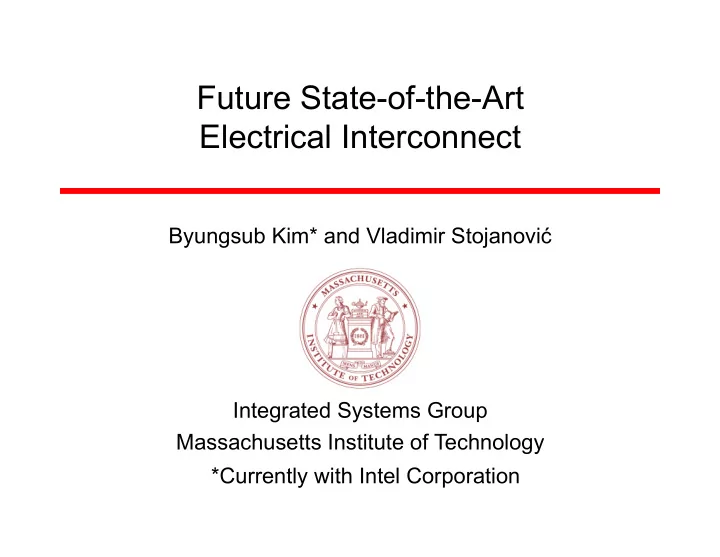

Future State-of-the-Art Electrical Interconnect Byungsub Kim* and Vladimir Stojanovi � Integrated Systems Group Massachusetts Institute of Technology *Currently with Intel Corporation
Many-core processor era Tilera 64 core processor � 1000 cores in the future ? 2
Global interconnects for latency Mesh Flattened Butterfly Clos � Increasing number of cores � latency issue. � Global NoC interconnects are attractive. 3
Nanophotonic on-chip interconnect Batten et. al., Micro2009 � Large bandwidth with small energy cost per bit over long distance � Extra cost n CMOS compatible fabrication, extra area, energy overhead. n We are keep improving … 4
The winning interconnects? ? nanophotonics electrical repeater � Nanophotonics v.s. electrical repeater � Compare bandwidth and power consumption. 5
The winning interconnects? nanophotonics ? electrical repeater � Equalized interconnects. � Consideration on area and latency. electrical equalizer 6
Outline � Fair comparison metrics. � Trade-off of repeated interconnects. � Trade-off of equalized interconnects. � Status of equalized electrical interconnects based on silicon measurement. 7
Fair interconnect metrics? For a given target distance � Data rate density = (Data rate)/ (cross-sectional width) � Energy per bit � Latency � In general, we cannot normalize these metrics by length. 8
Trade-off: repeated interconnects 1cm long 32nm technology (http://ptm.asu.edu) aggressively scaled KIM D&T 2008 � Repeater trade-off: three dimensional surface. n Wires and circuits are jointly optimized. 9
Trade off: repeated interconnects � Same energy per bit: same capacitance � Larger data rate density : Tsb < Tsa 10 � Larger latency : Tdb > Tda
Trade-off: repeated interconnects 1cm long 32nm technology (http://ptm.asu.edu) aggressively scaled KIM D&T 2008 � Repeater trade-off: three dimensional surface. n Wires and circuits are jointly optimized. 11
Equalized Interconnects � Potentially lower power and higher data rate than repeaters. 12
Evolution of equalized interconnects 1-cm links 2005, 130nm, Eq. 2005, 130nm, Rpt. Evolution of Eq. Evolution of Rpt. 2007, 90nm, Rpt. (modeling) 2009, 90nm, Eq. 2007, 90nm, Eq. 13
Review: equalization in frequency domain + = + Tx: HPF Channel: LPF Rx: HPF Overall: flat higher data rate 14
Review: equalization in time domain No equalization Feed forward equalization (FFE) FFE + decision feedback equalization (DFE) 15 15 15
Trade-off: equalized interconnect Sense amplifier !"!& !"!$ ! 03/9 ! !"!$ ! !"!& ! !"!( ! !"!* ! !"# !"$ !"% !"& !"' !"( !") !"* !"+ ./01-231456738 � Rx can sense small voltage ~ 100mV. � Tx swing is adjusted for target eye size (constant). � Tx swing is proportional to attenuation. � By rule of thumb, energy per bit cost 16
Review: power consumption of equalization Kim ICCAD 2007 Driver power overhead: used be > 50% � <25%) � Power overhead required n New topologies greatly reduced power overhead. n Eg.) Kim ISSCC2009, Mensink ISSCC2007, … 17
Trade off: equalized interconnect Equalized and unequalized pulses corresponding for isolated ‘1’ at Tx and Rx (90nm technology) � For a given data rate density tareget, latency is Tx No Eq. fixed. � The channel determines equalized Tx and Rx waveforms and the proper Rx No Eq. sampling time T d (latency). Tx Eq. Rx Eq. Kim ICCAD 2007 T d 18
Trade-off: equalized interconnects 1cm long 32nm technology (http://ptm.asu.edu) aggressively scaled KIM D&T 2008 � Trade-off curve of equalized interconnect is 3- dimensional line. 19
The winning interconnect � Depends on application requirements. � In general, n Rpt. wins in short distance (<5mm) or long distance applications (>10mm). 20 n Eq. wins in medium distance (5mm-10mm).
Current status: equalized interconnects 10mm long 5mm long Kim JSSC 2010 Tam VLSI 2009 Seo ISSCC2010 Mensink ISSCC 2009 � 2-3Gb/s/um with 400fJ/b-600fJ/b over 10mm in 90nm CMOS ASIC technology. � We can expect further improvement in 22nm high-performance processor technology. 21
Conclusion � To set the right direction of nanophotonics, we must compare them to the winning electrical interconnects, either repeated or equalized. � Fair comparison metrics n data rate density, energy per bit, and latency. � A repeated interconnect trade off is a 3-dimensional surface. n latency �� data rate density � Equalized interconnects provide better energy efficiency for the same performance in many situations than repeated ones. � There is no absolute winner. n In general, an equalized interconnect is better for 5-10mm distance. 22
Recommend
More recommend